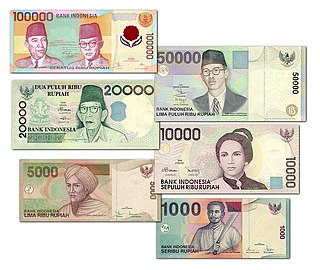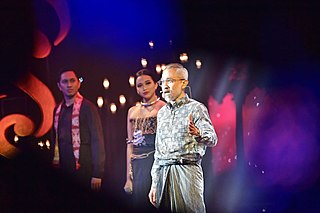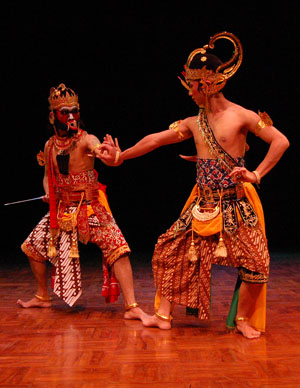I Gusti Ngurah Putu Wijaya is an Indonesian author, considered by many to be one of Indonesia's most prominent literary figures. His output is impressive; his published works include more than thirty novels, forty dramas, a hundred short stories, and thousands of essays, articles, screenplays and television dramas, and he has been the recipient of a number of literary prizes.

The first banknotes used in the archipelago that would become Indonesia were those issued by the United East India Company, credit letters of the rijksdaalder dating between 1783 and 1811. Netherlands Indies gulden government credit paper followed in 1815, and from 1827 to 1842 and again from 1866 to 1948 gulden notes of De Javasche Bank. Lower denominations were issued by the government in 1919–1920 and in 1939–1940 due to wartime metal shortages, but otherwise day-to-day transactions were conducted using coinage.

Revalina Trinovianti Sayuthi Temat, Revalina Trinovianti Gunawan or better known as Revalina S. Temat is an Indonesian actress and model of mixed Malay and Minangkabau descent.

Nasi pecel also known as Sega pecel in Javanese is an Indonesian rice dish from Java served with pecel. The vegetables are usually kangkung or water spinach, long beans, cassava leaves, papaya leaves, and in East Java often used kembang turi. It is often eaten with fried tempeh and traditional crackers called peyek. It is popular in East and Central Java.

Large-scale Japanese migration to Indonesia dates back to the late 19th century, though there was limited trade contact between Japan and Indonesia as early as the 17th century. As of October 2009, there were about 11,263 Japanese expatriates in Indonesia. At the same time, there are also identifiable populations of descendants of early migrants, who may be referred to as Nikkei Indonesians or Indonesian Nikkei.

Setiawan Hanung Bramantyo is an Indonesian director known for his films ranging from teen romances to religious dramas.

Dewi "Dee" Lestari Simangunsong is an Indonesian writer, singer, and songwriter.

Slamet Rahardjo Djarot is an Indonesian actor, director, and screenwriter of Javanese-Bantenese descent. He is the elder brother of director, songwriter, and politician, Eros Djarot. Since his directorial debut in 1979 with Rembulan dan Matahari, he has directed and/or written twelve films; one of which, Langitku, Rumahku, was Indonesia's submission to the 63rd Academy Awards in 1991.

Kembang-Kembang Plastik is a 1977 Indonesian film directed by Wim Umboh. Starring Cok Simbara, Dien Novita, Maruli Sitompul, and Roy Marten, it details the lives of people living in a prostitution district in Semarang. It has interpreted as giving a sympathetic perspective of their plight, but received mixed reception.

Adipati Koesmadji, better known by his stage name Adipati Dolken, is an Indonesian actor and model of mixed German and Javanese descent.

Reza Rahadian Matulessy is an Indonesian actor, model, singer and director of Persian and Ambonese descent. He is the Chair of the Indonesian Film Festival for the period 2021 to 2023.

Lukman Sardi is an Indonesian actor of Javanese-Bugis descent. He is the son of Indonesian violinist Idris Sardi and a grandson of Indonesian actress, Hadidjah.

Kue kembang goyang or kuih loyang is an Indonesian cuisine and Malaysian cuisine flower-shaped traditional snack (kuih), associated with Betawi cuisine and Malay cuisine.

Chandra Ariati Dewi "Ria" Irawan was an Indonesian actress and singer of Minangkabau descent.

Ayunda Faza Maudya, known as Maudy Ayunda, is an Indonesian pop singer and actress.

Marlia Hardi was an Indonesian actress who was active from 1950s to 1980s. Born in the Magelang, she took to the stage in the 1940s before moving to Jakarta in 1949. Two years later she made her feature film debut in Untuk Sang Merah Putih. Over the next two decades she appeared in over seventy films, became recognized for her depictions of mothers, and received the Citra Award for Best Supporting Actress. Despite her productiveness, however, she sank into debt and committed suicide at the age of fifty-eight.
The Tangerang fireworks disaster occurred on 26 October 2017 at the PT. Panca Buana Cahaya Sukses, a fireworks manufacturing factory in Kosambi, Tangerang, Indonesia. The explosion occurred in a warehouse connected to the factory and ignited a large fire. A hundred and three people were working at the factory at the time of the explosion. At least 49 people were killed and 46 others were injured in the fireworks accident. Authorities confirmed that several people were still missing. It was the deadliest industrial accident in Indonesia.

Bambangan Cakil is a classical dance-drama of Javanese people in—particularly—Central Java, Indonesia. This dance-drama demonstrates wayang performance due to the movement is adopted from one of the scenes in wayang kulit performance, that is the Perang Kembang scene. The Perang Kembang told about war between kesatria and raksasa. The kesatria has soft and gentle characters, while the raksasa is described as a character who is rough and violent.

Baksa Kembang is one of the classical Banjar dances originating from South Kalimantan, Indonesia, which functions as a welcoming dance for guests. This dance is usually played by female dancers with the condition that the number of dancers must be odd.

Lengger is a traditional Javanese dance originating from Banyumas, Central Java, Indonesia. This dance is played in pairs, between a man and a woman. Lengger dance is one of the sacred dances in Java.

















